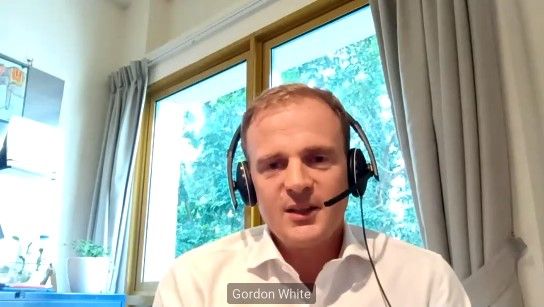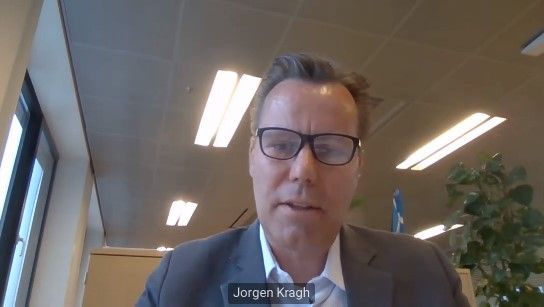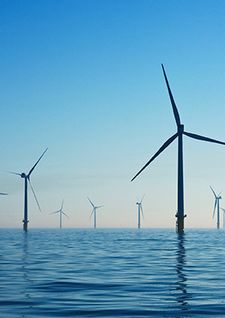Rod Morrison: Good afternoon ladies and gentlemen. Welcome to the Refinitiv Project Finance International Taiwan and South Korea offshore wind roundtable, sponsored by MUFG and Linklaters.
We are lucky enough today to be joined by a top panel of speakers, which should make this event very illuminating for those interested in the key sector of the global energy transition story.
The offshore wind concept is now very well established in East Asia. The opportunity is exciting and the market potentially very large. But, as with every opportunity, there come challenges: finding the optimum financing package; negotiating the regulatory framework; addressing local construction idiosyncrasies; the cost of insurance etc. We shall discuss all these issues today.
We’ll start with some introductory remarks from the speakers on what is needed right now to encourage the successful financing implementation of offshore wind schemes. We’ll then move on to discuss our target markets today: Taiwan and South Korea.
First, I would like to introduce Gordon White. Gordon is a director of Power Renewables, Asia Investment Banking Division, MUFG Bank.
Gordon White: Good day everybody, it’s a pleasure to be on the panel. Rod asked me to talk about issues in the Asian offshore wind markets, but I think that, before we launch into the main body of the discussion, I should do a bit of scene setting. And I will do so with a fair degree of optimism ¬- to begin with at least.
When we talk about offshore wind in East Asia, we are really talking about the Taiwan market, the up-and-coming market in Japan, Korea is not far behind, and Vietnam, which is probably the next one on the list. Today’s panel is focused on Taiwan and Korea.
Taiwan’s market has come a long way in a relatively short period of time and that’s the reason we can be very optimistic about other markets.
In Taiwan and Korea, specifically, governments have set ambitious targets. That has laid the groundwork for a healthy pipeline of opportunity, and that is the reason for it attracting a lot of interest from around the globe.
As an aside, it’s worth noting that each time targets are announced or revisited then ambitions seem to increase. I think Linklaters will probably say a few words on the specifics of those targets in a little bit.
Looking at Taiwan. As I said, the market has come a long way over the last three or four years. Its progress is impressive. As we stand here now, there have been five projects signed, representing two gigawatts (GW) of capacity and attracting financing of around US$10bn in project finance debt. At the start of 2018, the number of projects was zero, and the amount of project finance debt raised in Asian offshore wind was also zero. The industry has matured enormously over a very short period.
Taiwan’s experience explains my optimism, but I’m sure there will be challenges ahead, particularly given the size of governmental ambitions.
Offshore wind is going through the normal growing pains of a rapidly developing industry. And the onus is on us in the industry to resolve any issues as quickly as possible so that we can seize the opportunities at hand.
Specifically, the industry needs to navigate the regulatory environment. Each country has slightly different regulations and, as is normal with a new market, the regulations are continually evolving, being updated and changing. Keeping track of the regulatory changes is a challenge for everyone, as is finding a way to make them bankable.
For the sponsors, the challenge is how to convert ambitious targets into actual projects on the ground ready for construction.
Then we can’t have a session about Taiwan and Korea without mentioning localisation. That is another challenge. And different markets have a slightly different approach to localisation.
Linked to that is the supply chain, which is another common issue of a rapidly developing market going through growing pains. When you combine localisation and the need to develop a supply chain in a local market at such a rapid pace, then there are bound to be challenges. The industry is working through them.
The issue of the supply chain, more generally, also probably captures insurance. We’ll probably touch on that a bit later in the panel.
Then there’s also financing liquidity. When you look at the size of the targets and the amount of financing required to reach those targets, then it’s enormous. The US$10bn that we’ve raised to date is just a fraction of what’s needed over the medium to long term.
That’s a quick survey of the key points and I suspect we’ll pick up on some of those themes as we go through the session.

Rod Morrison: That’s a great introduction and sets the scene perfectly for today’s discussion. I’d now like to move on to Joo Hee Lee who is the national managing partner in Seoul of Linklaters.
Joo Hee Lee: Hi everyone. I am the national managing partner and head of our energy infrastructure team, based in Seoul.
Gordon has given such a great overview that he’s actually said most of what I was planning to say.
Gordon, you are right to say that we are going to mention capacity. So, let’s dive into that. We are looking at 15GW over the next 10 years in Taiwan and 12GW in Korea.
It will be very interesting to see how the market’s experience in Taiwan is going to play out in Korea and I look forward to discussing those things in more detail today.
Rod Morrison: Moving on to Thomas Poulsen, partner at Copenhagen Infrastructure Partners (CIP), which has been involved in Taiwan’s offshore wind. Thomas, the question I guess we set at the start was: what are the main issues when it comes to financing the offshore wind industry in East Asia?
Thomas Poulsen: As Gordon explained, what has happened in Taiwan’s offshore wind market is quite an incredible story: five projects and US$10bn of debt but also huge amounts of equity being committed over a very short timeframe.
These projects are now all in construction and it is important for them to pull through to completion in good fashion. They need to show that, not only have they been able to attract a lot of capital from lenders and from equity sponsors, but that they have been turned into good projects for Taiwan. That they have made a good first step for offshore wind in the region.
Progress in these projects will continue to attract a lot of attention as they will set the template for future projects, especially when it comes to localisation requirements.
It is not just a question of financing the projects but also building up the supply chain, which to some degree will include inexperienced suppliers. That’s the real challenge for now and for the next few years. The success of Taiwan’s projects will lay the foundation for how this market spreads throughout the region.
Rod Morrison: As a leading developer, Thomas, are you worried about insurance issues or the availability of insurance for these projects?
Thomas Poulsen: I don’t know whether I’m worried about it, Rod, but I think we are definitely paying more attention to insurance and the available capacity in the market. As a developer and project owner we are spending more time on insurance than we would otherwise do in Europe, where it is a little bit more straightforward.
There is a liquidity issue in the market. It can be managed but it’s something you would need to be very alert to. It’s especially true for Natural Catastrophe (NatCat) insurance but it’s also true for other insurance elements.
The market is constrained due to several different reasons. As a developer you need to spend a lot of time talking to the insurance market. It’s not just a case of taking out insurance the way we did before for these projects. It requires a lot more interaction with the market. You need to explain not only the risk but also why the thresholds are as they are.
Rod Morrison: Just quickly, as an international developer you don’t have a set template for financing, do you? To put it bluntly, do you take what’s available or do you marry your strategies to the local environment?
Thomas Poulsen: It depends on which technology you are talking about because we can also finance with 100% equity - and we do. When you finance a 600 megawatt (MW) offshore wind project, then a very large amount is required, and it is projects of this type of scale for which we look for funds from the financing markets.
There are some interesting developments going in Taiwan. For example, Changfang & Xidao, which was our first offshore wind project, was driven by huge involvement from the ECA markets and dominated by international banks.
We have another project that we will finance and which we are trying to close by the end of this year. This will be done in a slightly different way, but the main difference you will see is that the local market will play a much, much larger role in it. It will open access to domestic liquidity. We know there is plenty of liquidity in the domestic banks, but they have been a bit slow in contributing to projects as, perhaps, offshore wind is new to them as, too, are international financing structures.
Banks will become more used to lending to offshore wind over time as the education process continues but if you want to finance 10GW or 15GW of offshore wind in Taiwan, then there’s no doubt that you simply need to find the structures that work in the local financing markets. The liquidity is there, all developers will have to is adjust to the local financing markets in order to unlock it.
Rod Morrison: Moving on to Ryan Shin. Team head, deputy general manager Asia Pacific project finance for Korea Development Bank.
Ryan Shin: Thank you Rod. Let me just drop straight into Korea specific aspects. Overall, the Korean government has ambitious plans for offshore wind of about 15GW by 2030. As of today, we only have about 0.1GW in operation so far, so less than 1% compared to the overall target.
Foreign investors are very interested in the market and there’s a good commitment to develop offshore wind farms in Korea. However, the two precedents we have so far have seen technical problems in the COD stage. So, there is a general scepticism as to how many offshore wind farm projects will be executed successfully. As of 2019, 24 offshore wind farm projects equal to around 3GW of power have attained EBL approval but we’re not seeing much progress on these projects.
Why the progress so slow? It’s mainly due to permits, acceptability by the residents, transmission line, REC regime, and so on. and so on. We’ll talk more specifically about those issues later.
Rod Morrison: Thank you very much. Let’s go to Seung Soo Han.
Seung Soo Han: Thank you. I’m the commercial development director, Asia and general manager Korea at Northland Power. I was a power financier in Singapore for 10 years before returning to Korea about three years ago.
Liquidity is not a problem in Korea, there’s plenty in the market, so financing offshore wind projects will not be an issue.
The challenges lie elsewhere. In Korea the tariff price is fixed but only fixed close to the financial close. So, that price risk will affect your project bankability.
That’s one of the main issues. The second biggest issue is build capacity. Whether building capacity will be available for those projects, is questionable.
The Renewable Energy Certificate (REC) tariff price and build capacity are going to be the main challenges for offshore wind in Korea.
Rod Morrison: Moving on to Quentin Slight, managing director and head of energy and infrastructure group Asia for Credit Agricole CIB.
Quentin Slight: Thank you Rod. Going back to the introductory question: what are the key challenges? There are several challenges and the other panellists have eloquently covered them.
I agree with Thomas and Ryan in the sense that one of the most important criteria is the successful completion of projects. We know that there are a couple in Taiwan where construction was constrained for a combination of reasons, such as availability of vessels and Covid, but we are very confident that these projects will reach completion successfully. That will really set the tone for the market, and really whet the appetite for debt and equity investors.
There is plenty of liquidity in Asia. It’s encouraging to see the increasing participation of Taiwanese banks and I think that the development of a bond market for projects in Taiwan, allowing banks to recycle capital, will also be important mobilising significant amounts of liquidity.
In Korea, there is undeniably significant liquidity. The question is on what terms it will be available for offshore wind projects. Everyone needs to get comfortable with this particular asset class and the higher risk profile.
The last point is the dichotomy between growth in the development of a local supply chain, which is entirely beneficial, and the impact that has on the ability to raise export credits for financing. That’s a challenge that needs to be thought through.
Rod Morrison: Just one thing, Quentin. Are you concerned about some of the supply chain issues that are emerging or do you think that’s just growing pains, as Gordon said?
Quentin Slight: I agree with Gordon. I try not to agree with him all the time but in this instance, he’s absolutely right. Yes, it’s growing pains of the industry. In Europe, the offshore wind sector has been going for something like 20 years, and we know that the initial projects faced significant problems. Here, the development has been dramatic. So, it’s to be entirely expected that, in such a condensed period of time, there will be some growing pains.
There is an industrial strength in Asia and I’m sure that the relevant industries, with appropriate government support, will rise to the challenge and will get through this “teenage” stage.
Rod Morrison: Moving to export credits and Jørgen Kragh who is from one of the leading ECAs in the field. He’s head of offshore wind and project finance, global wind and structured finance at Denmark’s EKF.
Jørgen Kragh: Yes, thank you. The focus for EKF as an export credit agency (ECA) is to make new markets for exporters. We made a great start in Taiwan where we participated in the first five transactions. Now, going forward, our focus will be very much on South Korea and Japan, where we hope we can replicate some of the structures that have been successful in Taiwan. The reason we made such a good start in Taiwan is because the government decided upon a framework that gave predictability to the pipeline. So, developers and manufacturers could see that the market has a future.
Naturally, localisation of the supply chain will increase over time. Typically, in the development of these markets, we participate in the first projects and then more local participation comes in for future projects and there’s less need for ECAs like EKF. But it does take some years for this supply chain to fully develop.
We think there’s still a big market for us in Taiwan and we remain focused on the market.
Rod Morrison: Are there old-fashioned project finance credit triggers you need as a baseline when you investigate a new market? Are there baseline project finance requirements you need to take these deals forward?
Jørgen Kragh: Definitely, for us, there must be a Danish economic interest. Generally, EKF has been involved in the project finance of deals where we participate on equal terms with the international banks and local banks. We don’t see ourselves as very special. We are a bank and we work together with the commercial banks In Taiwan. Now there are seven or eight ECAs which have taken risk on the offshore side. So, there’s definitely an ECA market to dip into.
Rod Morrison: Now we can move on to Taiwan proper and Ying Fu, counsel in Hong Kong for Linklaters, who will make some introductory remarks on the Taiwanese market, what’s happened in the past and, more excitingly, what’s going to happen in the future.
Ying Fu: Thanks very much. So, it’s certainly been a very interesting time for Taiwan, which has been incredibly successful in developing the offshore wind market and securing some really significant investments - including from some of my fellow panellists today.
Recent announcements of increases to planned capacity for the next allocation round plus ongoing strong demand side factors, including an increase in industrial demand for green energy due to the nuclear generation phase out, all point to Taiwan’s success story continuing.
On the other hand, you have examples of existing capacity allocated in previous rounds that has not yet been financed or is yet to go through construction. And again, as highlighted by the fellow panellists, there have been some inevitable new market growing pains, exacerbated by Covid. The question as to whether the market is slowing down or speeding up is very apt.
Fortunately, as with my fellow panellists, Linklaters has been involved in the market since the very early days. So, as a group, we’re well placed to give some views on this question.
Before we analyse it, I think it’s useful to have a general recap of what the latest announcements say about the upcoming allocation rounds. Some rules announced in the last couple of weeks, which have increased the capacity to be allocated from 10GW to 15GW over the 10 years from 2026. This will be allocated in phases with the first bids to take place next year.

To see the digital version of this report, please click here
To purchase printed copies or a PDF of this report, please email gloria.balbastro@refinitiv.com
